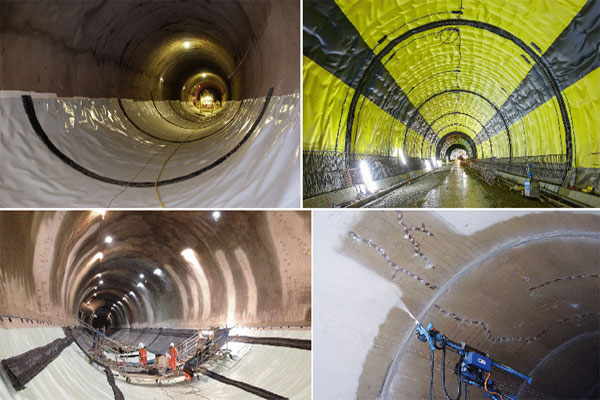Tunnel waterproofing is one challenging work undertaken. This type of waterproofing systems are faced with very strict requirements regarding durability, exposure, sustainability, and stress conditions. For waterproofing in tunnels or underground structures, it is important to consider the entire system rather than the individual waterproofing layers.With respect to the durability of underground structures, the ingress of water is usually the most important factor to be considered. For such cases, considerations of chemical interactions of pollutants with the waterproofing system are of major importance.
Components of tunnel waterproofing
The waterproofing membrane relies on various components that need to be compatible with each other and applied in the correct sequence to give a desired result.
- The basic support surface on which the layers of the proofing system are installed.
- The compensation layer, which makes up for uneven substrates
- The drainage element which collects and disposes of water on the rear side of the waterproof layer
- The sealing element or impermeable layer generally includes a waterproof membrane
- The protective layer that separates and protects the waterproof membrane from the concrete casting filling material
- The partitioning element that divides surfaces into sections to help locate leaks.
- The injection and control element enables the integrity of the sealed surfaces and any resins injected into partitioned sectors to be checked.
Different types of tunnel waterproofing systems
It Is essential to remember that waterproofing systems have to be selected and planned in order to represent the optimal solution with regard to given requirements pertaining to its intended use on one hand and technically & economically acceptable possibilities on the other. The key criteria in selecting these systems are, hydrology concept, permanent water table, the degree of water tightness required, drained or undrained concept, the height of water pressure, the impacts and conditions during construction etc.
Hybrid waterproofing system
Hybrid waterproofing membranes combine active polymer barrier technology with conventional passive-bonded product technology. By incorporating multiple barrier materials in a single waterproofing membrane, the new active polymer hybrid membranes compensate for the shortcomings of traditional materials.

The spray applied waterproofing system
The spray applied waterproofing system in tunnels is used with single shell linings. The conditions of the application of this system are analyzed in terms of the deformation and surface condition of the first layer of the shotcrete shell, water ingress and water pressure behind the waterproofing membrane. This method can bond to both the primary and secondary linings. The application of the membrane can be executed by a dry shotcrete machine.

Sheet Membrane waterproofing system
Sheet membrane systems are available in Rubber, Neoprene, high-density polyurethane, (HDPE) and combinations of rubber and HDPE. They are provided as rolls usually approximately 2-3 meters in width and are self-adhered. During application, the roll is laid out flipped over and the backing removed. The sheet is placed on the surface with the adhesive and pressed into place. The sheets can be applied either as a blindside waterproofing against sheet piling or a temporary support system or can be applied after partial cure of the concrete.

The epoxy Liner waterproofing system
These are two-component systems and generally are produced in two formulations: one for horizontal surfaces and one for vertical surfaces. The difference is that the vertical material is non-sag to better adhere to the vertical surfaces. The formulations are not interchangeable due to the requirement to have non-sag for vertical surfaces to develop the required thickness. Typical installation of epoxy systems is performed by spraying the epoxy.

PVC waterproofing system
The double-layered system of PVC-P, in combination with waterstop, injection valves, hoses, a tunnel waterproofing system can be divided and compartmentalised into small independent watertight sections. The tunnel/ structure is therefore divided into manageable sections that can be treated as individual entities. This system allows us to test for water-tightness at locations suspected of accidental damage, or in the case of leakage. Furthermore, the water infiltrations would be limited to the single damaged section/compartment. Any damage/leakage would remain localised, thus rendering easy rectification, and thereby mitigating one of the major concerns with traditional PVC-P applications. This compartmentalization forms this watertight control by utilising the gap between the two waterproofing membrane layers. This gap can be exploited to monitor the waterproofing system sealing and allows for simple future repairs by resin injection.PVC-P twin layer membrane is generally used as a waterproofing membrane, must be highly durable and shall be judiciously selected. The product should be made up of virgin PVC compound and plasticized for long term flexibility and durability. The membrane shall be supplied with a signal layer, i.e. a thin sheet of different colour, bonded to one side, which is intended to facilitate the detection of damage.

Crystalline integral waterproofing system
Crystalline integral waterproofing solutions protect the structural rebar from corrosion and provide a durable, leak-free solution that will last for the life of the tunnel. These solutions are easy to use and do not require special weather conditions. This waterproofing system is designed for use in above- and below-grade applications, MasterLife 300 series admixtures react in concrete to form non-soluble crystalline hydration products in the capillary pores of the concrete. These crystalline hydration products effectively reduce the permeability of concrete and seal the hairline cracks.

Conclusion
A long service life of tunnel construction requires durability of all components. A major part in this context plays the waterproofing layer and various components, especially those which are supposed to blend together. The designers,owners and project managers should select the complete system judiciously and understand in detail the functioning of each component, which together shall work in designed period of life and not just the warranty period
Image source: chryso.in, fosroc.com, master-builders-solutions.com, sika.com

